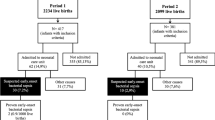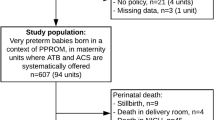Abstract
Objective
Term infants born to mothers with chorioamnionitis are at risk for early-onset sepsis (EOS). We aimed to measure the impact of changing from a categorical to a modified-observational EOS screening approach on NICU admission, antibiotic utilization, and hospitalization costs.
Study design
Single-center retrospective pre-post cohort study of full-term infants born to mothers with chorioamnionitis. Primary outcomes included NICU admission, antibiotic utilization, and hospitalization costs. Outcomes were adjusted for demographic variables. Budget-impact analysis was performed using bootstrapping with replication.
Results
380 term infants were included (197 categorical; 183 modified-observational). There was a significant decrease in NICU admission and antibiotic utilization (p < 0.05) in the modified-observational cohort but no significant difference in per-patient total hospitalization costs. Budget-impact analysis suggested a high probability of cost savings.
Conclusion
A modified-observational approach to evaluating term infants of mothers with chorioamnionitis can reduce NICU admission and unnecessary antibiotic therapy, and may lead to cost-savings.
This is a preview of subscription content, access via your institution
Access options
Subscribe to this journal
Receive 12 print issues and online access
$259.00 per year
only $21.58 per issue
Buy this article
- Purchase on Springer Link
- Instant access to full article PDF
Prices may be subject to local taxes which are calculated during checkout


Similar content being viewed by others
Data availability
Available on request.
References
Briggs-Steinberg C, Roth P. Early-onset sepsis in newborns. Pediatr Rev. 2023;44:14–22. https://doi.org/10.1542/pir.2020-001164.
Benitz WE, Wynn JL, Polin RA. Reappraisal of guidelines for management of neonates with suspected early-onset sepsis. J Pediatr. 2015;166:1070–4. https://doi.org/10.1016/j.jpeds.2014.12.023.
Puopolo KM, Lynfield R, Cummings JJ. Committee on Fetus and Newborn; Committee on Infectious Diseases. Management of infants at risk for Group B streptococcal disease [published correction appears in Pediatrics. 2019 Oct;144:]. Pediatrics. 2019;144:e20191881. https://doi.org/10.1542/peds.2019-1881.
Puopolo KM, Benitz WE, Zaoutis TE. Committee on Fetus and Newborn; Committee on Infectious Diseases. Management of neonates born at ≥35 0/7 weeks’ gestation with suspected or proven early-onset bacterial sepsis. Pediatrics. 2018;142:e20182894 https://doi.org/10.1542/peds.2018-2894.
Risnes KR, Belanger K, Murk W, Bracken MB. Antibiotic exposure by 6 months and asthma and allergy at 6 years: Findings in a cohort of 1,401 US children. Am J Epidemiol. 2011;173:310–8. https://doi.org/10.1093/aje/kwq400.
Saari A, Virta LJ, Sankilampi U, Dunkel L, Saxen H. Antibiotic exposure in infancy and risk of being overweight in the first 24 months of life. Pediatrics. 2015;135:617–26. https://doi.org/10.1542/peds.2014-3407.
Trasande L, Blustein J, Liu M, Corwin E, Cox LM, Blaser MJ. Infant antibiotic exposures and early-life body mass. Int J Obes. 2013;37:16–23. https://doi.org/10.1038/ijo.2012.132.
Verani JR, McGee L, Schrag SJ. Division of Bacterial Diseases, National Center for Immunization and Respiratory Diseases, Centers for Disease Control and Prevention (CDC). Prevention of perinatal group B streptococcal disease-revised guidelines from CDC, 2010. MMWR Recomm Rep. 2010;59:1–36. (RR-10)
Wortham JM, Hansen NI, Schrag SJ, Hale E, Van Meurs K, Sanchez PJ, et al. Chorioamnionitis and culture-confirmed, early-onset neonatal infections. Pediatrics. 2016;137:e20152323. https://doi.org/10.1542/peds.2015-2323.
Dhudasia MB, Benitz WE, Flannery DD, Christ L, Rub D, Remaschi G, et al. Diagnostic performance and patient outcomes with C-reactive protein use in early-onset sepsis evaluations. J Pediatr. 2023;256:98–104.e6. https://doi.org/10.1016/j.jpeds.2022.12.007.
Berardi A, Fornaciari S, Rossi C, Patianna V, Bacchi Reggiani ML, Ferrari F, et al. Safety of physical examination alone for managing well-appearing neonates ≥ 35 weeks’ gestation at risk for early-onset sepsis. J Matern Fetal Neonatal Med. 2015;28:1123–7. https://doi.org/10.3109/14767058.2014.946499.
Flidel-Rimon O, Galstyan S, Juster-Reicher A, Rozin I, Shinwell ES. Limitations of the risk factor based approach in early neonatal sepsis evaluations [published correction appears in Acta Paediatr. 2013 Aug;102(8):840]. Acta Paediatr. 2012;101:e540–e544. https://doi.org/10.1111/apa.12013.
Joshi NS, Gupta A, Allan JM, Cohen RS, Aby JL, Weldon B, et al. Clinical monitoring of well-appearing infants born to mothers with chorioamnionitis. Pediatrics. 2018;141:e20172056. https://doi.org/10.1542/peds.2017-2056.
Achten NB, Klingenberg C, Benitz WE, Stocker M, Schlapbach LJ, Giannoni E, et al. Association of use of the neonatal early-onset sepsis calculator with reduction in antibiotic therapy and safety: a systematic review and meta-analysis. JAMA Pediatr. 2019;173:1032–40. https://doi.org/10.1001/jamapediatrics.2019.2825.
Dhudasia MB, Mukhopadhyay S, Puopolo KM. Implementation of the sepsis risk calculator at an academic birth hospital. Hosp Pediatr. 2018;8:243–50. https://doi.org/10.1542/hpeds.2017-0180.
Achten NB, Dorigo-Zetsma JW, van der Linden PD, van Brakel M, Plötz FB. Sepsis calculator implementation reduces empiric antibiotics for suspected early-onset sepsis. Eur J Pediatr. 2018;177:741–6. https://doi.org/10.1007/s00431-018-3113-2.
Beavers JB, Bai S, Perry J, Simpson J, Peeples S. Implementation and evaluation of the early-onset sepsis risk calculator in a high-risk university nursery. Clin Pediatr. 2018;57:1080–5. https://doi.org/10.1177/0009922817751337.
Gievers LL, Sedler J, Phillipi CA, Dukhovny D, Geddes J, Graven P, et al. Implementation of the sepsis risk score for chorioamnionitis-exposed newborns. J Perinatol. 2018;38:1581–7. https://doi.org/10.1038/s41372-018-0207-7.
Kuzniewicz MW, Puopolo KM, Fischer A, Walsh EM, Li S, Newman TB, et al. A quantitative, risk-based approach to the management of neonatal early-onset sepsis. JAMA Pediatr. 2017;171:365–71. https://doi.org/10.1001/jamapediatrics.2016.4678.
Mauskopf JA, Paul JE, Grant DM, Stergachis A. The role of cost-consequence analysis in healthcare decision-making. Pharmacoeconomics. 1998;13:277–88. https://doi.org/10.2165/00019053-199813030-00002.
How to use the searchable medicare physician fee schedule (MPFS): Centers for Medicare and Medicaid Services (CMS); 2017. Available from: https://www.cms.gov/Medicare/Medicare-Fee-for-Service-Payment/PFSlookup/index.html.
Dunn A, Grosse SD, Zuvekas SH. Adjusting health expenditures for inflation: a review of measures for health services research in the United States. Health Serv Res. 2018;53:175–96. https://doi.org/10.1111/1475-6773.12612.
Fenwick E, Marshall DA, Levy AR, Nichol G. Using and interpreting cost-effectiveness acceptability curves: an example using data from a trial of management strategies for atrial fibrillation. BMC Health Serv Res. 2006;6:52. https://doi.org/10.1186/1472-6963-6-52.
Husereau D, Drummond M, Augustovski F, de Bekker-Grob E, Briggs AH, Carswell C, et al. Consolidated Health Economic Evaluation Reporting Standards 2022 (CHEERS 2022) statement: updated reporting guidance for health economic evaluations. BJOG. 2022;129:336–44. https://doi.org/10.1111/1471-0528.17012.
Mihaylova B, Briggs A, O’Hagan A, Thompson SG. Review of statistical methods for analysing healthcare resources and costs. Health Econ. 2011;20:897–916. https://doi.org/10.1002/hec.1653.
Rallis D, Balomenou F, Karantanou K, Kappatou K, Tzoufi M, Giapros V. A comparison between risk-factor guidance for neonatal early-onset sepsis and Kaiser Permanente sepsis risk calculator in a Greek cohort. Early Hum Dev. 2021;155:105331. https://doi.org/10.1016/j.earlhumdev.2021.105331.
Sloane AJ, Carola DL, Lafferty MA, Edwards C, Greenspan J, Aghai ZH. Management of infants born to mothers with chorioamnionitis: a retrospective comparison of the three approaches recommended by the committee on fetus and newborn. J Neonatal Perinat Med. 2021;14:383–90. https://doi.org/10.3233/NPM-200531.
Pettinger KJ, Mayers K, McKechnie L, Phillips B. Sensitivity of the Kaiser Permanente early-onset sepsis calculator: a systematic review and meta-analysis. EClinicalMedicine. 2019;19:100227. https://doi.org/10.1016/j.eclinm.2019.11.020. Published 2019 Dec 22
Benincasa BC, Silveira RC, Schlatter RP, Balbinotto Neto G, Procianoy RS. Multivariate risk and clinical signs evaluations for early-onset sepsis on late preterm and term newborns and their economic impact. Eur J Pediatr. 2020;179:1859–65. https://doi.org/10.1007/s00431-020-03727-z.
Achten NB, Visser DH, Tromp E, Groot W, van Goudoever JB, Plötz FB. Early onset sepsis calculator implementation is associated with reduced healthcare utilization and financial costs in late preterm and term newborns. Eur J Pediatr. 2020;179:727–34. https://doi.org/10.1007/s00431-019-03510-9.
Gong CL, Dasgupta-Tsinikas S, Zangwill KM, Bolaris M, Hay JW. Early onset sepsis calculator-based management of newborns exposed to maternal intrapartum fever: a cost benefit analysis. J Perinatol. 2019;39:571–80. https://doi.org/10.1038/s41372-019-0316-y.
Author information
Authors and Affiliations
Contributions
CSL designed the work, acquired, analyzed, and interpreted the data, drafted the manuscript, and substantively revised the manuscript. AS assisted with data acquisition. CM assisted with data analysis. CBB conceptualized and designed the work, and substantively revised the manuscript. TH conceptualized and designed the work, and substantively revised the manuscript. MK conceptualized and designed the work. KS conceptualized and designed the work, and substantively revised the manuscript. TY conceptualized and designed the work, interpreted the data, and substantively revised the manuscript. BCK conceptualized and designed the work, acquired and interpreted the data, and substantively revised the manuscript. All authors approved the final manuscript as submitted and agree to be accountable for all aspects of the work.
Corresponding author
Ethics declarations
Competing interests
The authors declare no competing interests.
Additional information
Publisher’s note Springer Nature remains neutral with regard to jurisdictional claims in published maps and institutional affiliations.
Rights and permissions
Springer Nature or its licensor (e.g. a society or other partner) holds exclusive rights to this article under a publishing agreement with the author(s) or other rightsholder(s); author self-archiving of the accepted manuscript version of this article is solely governed by the terms of such publishing agreement and applicable law.
About this article
Cite this article
Liang, C.S., Sebastian, A., McKennan, C. et al. Clinical and economic impacts of a modified-observational screening approach to well-appearing infants born to mothers with chorioamnionitis. J Perinatol (2023). https://doi.org/10.1038/s41372-023-01858-3
Received:
Revised:
Accepted:
Published:
DOI: https://doi.org/10.1038/s41372-023-01858-3



